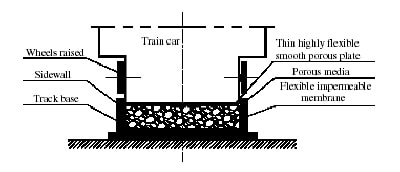What do trains, red blood cells and snowboarding have in common? More than you might think according to scientists who hope to develop a new type of train track based on lessons they have learned from the flow of blood through the body and experiments with a snowboarder. Sheldon Weinbaum and colleagues at the City College of New York claim that a track made of goose feathers is capable of supporting the weight of a moving train (Phys. Rev. Lett. 93 194501).

The lift force experienced by red cells as they move through capillaries is similar to that experienced by a snowboarder, even though blood cells and human beings differ in mass by a factor of 1015. For a snowboarder friction drag is reduced by a micron-thick fluid film that becomes trapped in the layers of snow beneath the snowboard.
Similarly, the drag on a red cell is reduced because a thin film of fluid is trapped between the cell and the endothelial surface layers in the blood vessel. However, the New York team found that soft porous materials – such as the inside of a blood vessel or soft snow – can generate lift forces that are a million times greater than the predictions of classical lubrication theory.
To measure the pressures that develop during snowboarding, Weinbaum and colleagues used a piston cylinder apparatus that was capable of reproducing the dynamic forces experienced by a moving snowboard (figure 1). They calculated that the air trapped in the snow can easily support the weight of a 70-kg snowboarder. They also found that the pore pressure underneath a snowboard with a surface area of 5000 square centimetres is about 1.4 kilopascals.
Extrapolating these results to the case of a 50-ton high-speed train, Weinbaum and co-workers calculated that 9.8 kilopascals of pore pressure would be needed to support a train that was 25 metres long and 2 metres wide. According to the scientists, a porous material with a permeability of 10-8 metres squared or smaller – such as goose down – could be used as a track that was capable of supporting the weight of the moving train (figure 2).
“Our work shows that soft porous layers filled with air or water can generate lift forces that can be a million times more than classical lubrication theory predicts,” Weinbaum told PhysicsWeb. “These forces could be sufficient to lift a train car on something as soft as a bed of feathers.” Although goose down is too expensive for practical applications, the team points out that there are many synthetic fibres with comparable mechanical properties.
The researchers say they applied ideas from blood flow to snowboarding and the design of a futuristic train track because of their “novelty”, but they stress that the basic concepts could be relevant in any application that involves bearings and lubrication.




